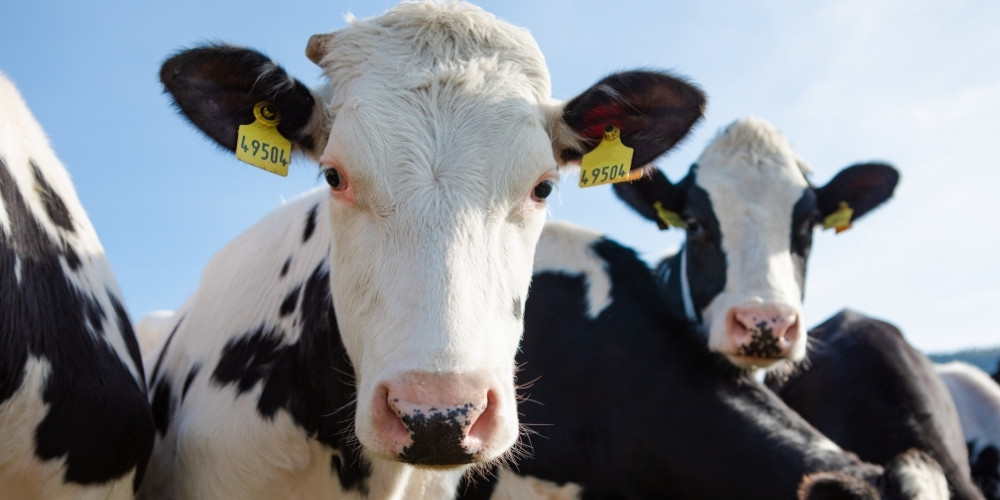ภาวะคีโตซิสในโคส่งผลต่อการผลิตนมอย่างไร? ทำความเข้าใจสาเหตุและอาการเพื่อป้องกัน!

ภาวะคีโตซิสในวัวเป็นความท้าทายที่เงียบงันแต่ร้ายแรงสำหรับผู้ผลิตปศุสัตว์ ความผิดปกติของระบบเผาผลาญนี้ทำให้องค์ประกอบของนมเปลี่ยนแปลงไป ลดปริมาณน้ำนม และอาจส่งผลให้เกิดปัญหาการสืบพันธุ์ในระยะยาว ซึ่งส่งผลให้ต้นทุนการผลิตเพิ่มขึ้นในที่สุด แม้ว่าภาวะคีโตซิสในวัวในระดับเล็กน้อยอาจหายได้เอง แต่กระบวนการฟื้นตัวมักจะช้า ซึ่งส่งผลกระทบต่อผลผลิตนมและรายได้ของเกษตรกร การตรวจพบและการรักษาในระยะเริ่มต้นมีความสำคัญเมื่อมีอาการคีโตซิสในวัว มาตรการป้องกันเชิงรุกยังเป็นสิ่งสำคัญในการลดภาวะคีโตซิสทางคลินิกในฟาร์มให้เหลือน้อยที่สุด
ภาวะคีโตซิสในวัวคืออะไร? ทำความเข้าใจอาการทางคลินิกและอาการที่ไม่ชัดเจน
ภาวะคีโตซิสในวัวนมมักเกิดขึ้นในช่วงต้นของการให้นมเนื่องจากได้รับสารอาหารแห้งไม่เพียงพอหรือได้รับสารอาหารไม่สมดุล ส่งผลให้ระดับน้ำตาลในเลือดต่ำ เมื่อระดับกลูโคสในเลือดไม่เพียงพอ วัวจะดึงไขมันในร่างกายมาใช้เป็นแหล่งพลังงานทางเลือก ส่งผลให้ร่างกายผลิตคีโตนมากเกินไป ส่งผลให้ระดับคีโตนในของเหลวและเนื้อเยื่อในร่างกายสูงขึ้น ภาวะคีโตซิสสามารถจำแนกได้เป็นภาวะทางคลินิกหรือภาวะที่ไม่ทางคลินิก ในทั้งสองกรณี การวัดความเข้มข้นของคีโตนอย่างแม่นยำถือเป็นสิ่งสำคัญในการประเมินการแพร่ระบาดในระดับฝูง การปรับปรุงสุขภาพโดยรวมของวัว และการเพิ่มปริมาณน้ำนม
ภาวะคีโตซิสทางคลินิก
นับตั้งแต่ทศวรรษ 1990 โรคคีโตซิสในวัวถือเป็นความผิดปกติทางเมตาบอลิซึมที่ส่งผลกระทบมากที่สุดในฝูงโคนมของสหรัฐฯ โดยอาการทางคลินิกมักมาพร้อมกับอาการทางระบบย่อยอาหารหรือทางระบบประสาท
ภาวะคีโตซิสแบบใต้คลินิก
ภาวะคีโตซิสแบบไม่แสดงอาการหมายถึงระดับคีโตนที่สูงในเลือด ปัสสาวะ หรือน้ำนม โดยไม่มีอาการที่มองเห็นได้
ผลกระทบทางเศรษฐกิจของภาวะคีโตซิสในวัวต่ออุตสาหกรรมปศุสัตว์ของไต้หวัน
ภาวะคีโตซิสแบบไม่แสดงอาการเพียงกรณีเดียวอาจส่งผลให้เกิดการสูญเสียทางการเงินประมาณ 78 ดอลลาร์สหรัฐ (ประมาณ 2,600 ดอลลาร์ไต้หวันใหม่) สำหรับฟาร์มที่มีวัวให้นม 100 ตัวและมีอัตราคีโตซิสแบบไม่แสดงอาการ 40% การสูญเสียทางเศรษฐกิจประจำปีอาจสูงถึง 3,120 ดอลลาร์สหรัฐ (ประมาณ 100,000 ดอลลาร์ไต้หวันใหม่) หากพิจารณาจากวัวให้นมประมาณ 50,000 ตัวของไต้หวัน ผลกระทบทางเศรษฐกิจประจำปีของประเทศอาจอยู่ระหว่าง 40 ถึง 50 ล้านดอลลาร์ไต้หวันใหม่
ภาวะคีโตซิสในวัวมี 3 ประเภท: สาเหตุและอาการ
ภาวะคีโตซิสในวัวนมโดยทั่วไปจะแบ่งออกเป็น 3 ประเภท โดยแต่ละประเภทมีสาเหตุและอาการทางคลินิกที่แตกต่างกัน ความสามารถของฟาร์มในการรับรู้และจัดการกับอาการคีโตซิสในวัวนั้นขึ้นอยู่กับความรู้ของเกษตรกรเกี่ยวกับการจัดการฝูงสัตว์และการป้องกันโรคในช่วงแรกของการให้นมเป็นส่วนใหญ่
ภาวะคีโตซิสชนิดที่ 1
ภาวะคีโตซิสชนิดที่ 1 หรือที่เรียกว่าภาวะคีโตซิสตามธรรมชาติหรือจากการให้อาหารไม่เพียงพอ มักเกิดขึ้น 3 ถึง 6 สัปดาห์หลังคลอดและเป็นรูปแบบที่พบบ่อยที่สุดในช่วงต้นของการให้นม โดยทั่วไปวัวจะดูมีสุขภาพดีในช่วงแรก โดยมีความอยากอาหารและปริมาณน้ำนมปกติ แต่เมื่อการให้นมดำเนินไป อาจมีภาวะสมดุลพลังงานติดลบและเกิดภาวะน้ำตาลในเลือดต่ำเรื้อรัง ภาวะนี้มักพบในฝูงสัตว์ที่ให้อาหารแบบดั้งเดิมและจะเด่นชัดมากขึ้นเมื่อปริมาณน้ำนมสูงสุด หากได้รับการรักษาที่เหมาะสม วัวที่มีภาวะคีโตซิสชนิดที่ 1 มักจะฟื้นตัวได้ดี
ภาวะคีโตซิสชนิดที่ 2
ภาวะคีโตซิสประเภทที่ 2 มักส่งผลต่อวัวที่มีน้ำหนักเกินหลังคลอดลูก และมักเกี่ยวข้องกับการจัดการที่ไม่ดีในช่วงการเปลี่ยนผ่าน ปัจจัยกดดัน เช่น การเลี้ยงวัวมากเกินไปก่อนคลอด การรวมกลุ่มใหม่บ่อยครั้ง และการให้อาหารมากเกินไปหลังคลอด อาจเป็นตัวกระตุ้นให้เกิดภาวะนี้ได้ วัวที่คลอดลูกครั้งแรกที่มีน้ำหนักเกินจะมีความเสี่ยงเป็นพิเศษ และอาจประสบปัญหาในการคลอดลูก รกค้าง หรือติดเชื้อในมดลูก ซึ่งแตกต่างจากประเภทที่ 1 ภาวะคีโตซิสประเภทที่ 2 อาจเกี่ยวข้องกับภาวะน้ำตาลในเลือดสูง แม้ว่าระดับคีโตนอาจต่ำกว่าก็ตาม
ภาวะคีโตซิสชนิดที่ 3
เรียกอีกอย่างว่าภาวะคีโตซิสจากกรดบิวทิริกในหญ้าหมัก ภาวะคีโตซิสประเภทที่ 3 มักเกิดจากการให้อาหารหญ้าหมักที่มีกรดบิวทิริกสูง โดยเฉพาะอย่างยิ่งเมื่อเก็บเกี่ยวข้าวโพดก่อนกำหนดหรือขาดคาร์โบไฮเดรตที่ละลายน้ำได้ อาหารที่ไม่สมดุลซึ่งมีโปรตีนและคาร์โบไฮเดรตสูงอาจทำให้มีการผลิตอะซิเตทและบิวทิเรตมากเกินไป ซึ่งจะถูกเปลี่ยนเป็นคีโตนบอดีจำนวนมากในเยื่อบุกระเพาะรูเมน ส่งผลให้วัวเกิดภาวะคีโตซิสในที่สุด
ตารางเปรียบเทียบ: ภาวะคีโตซิสในวัว 3 ประเภท
| ภาวะคีโตซิสชนิดที่ 1 | ภาวะคีโตซิสชนิดที่ 2 | ภาวะคีโตซิสชนิดที่ 3 | |
|---|---|---|---|
| สาเหตุ | การให้อาหารไม่เพียงพอ สมดุลพลังงานเชิงลบ | โรคอ้วน การแออัดหรือให้อาหารมากเกินไป | หญ้าหมักที่มีคีโตน กรดบิวทิริกจากการหมักคลอสตริเดียม |
| อาการทั่วไป | การผลิตน้ำนมเพิ่มขึ้น ภาวะน้ำตาลในเลือดต่ำ ปัญหาการย่อยอาหาร | ภาวะน้ำตาลในเลือดสูง, มดลูกลำบาก, การติดเชื้อในมดลูก | อาการผิดปกติของระบบย่อยอาหาร มีกลิ่นผิดปกติ |
| กลุ่มที่ได้รับผลกระทบ | วัวที่ให้ผลผลิตสูง 3–6 สัปดาห์หลังคลอด | แม่วัวอ้วนหลังคลอดลูก | ฝูงสัตว์ได้รับอาหารหมักจากอาหารที่ไม่สมดุล |
สามวิธีทดสอบที่สำคัญเพื่อป้องกันภาวะคีโตซิสในวัว
อาการคีโตซิสในวัวสามารถตรวจพบได้โดยการวัดระดับคีโตนในเลือด ปัสสาวะ หรือน้ำนม การวินิจฉัยภาวะคีโตซิสทางคลินิกทำได้เมื่อความเข้มข้นของคีโตนในร่างกายเกิน 30 มก./ดล. ในเลือด 84 มก./ดล. ในปัสสาวะ หรือ 10 มก./ดล. ในน้ำนม
การตรวจเลือด
คีโตนหลักๆ ได้แก่ อะซิโตน กรดอะซิโตน (AAA) และกรดเบตาไฮดรอกซีบิวทิริก (BHB) เครื่องวัดน้ำตาลในเลือดและคีโตนเชิงพาณิชย์สามารถวัด BHB ในเลือดวัวได้อย่างแม่นยำ และถือเป็นมาตรฐานทองคำในการวินิจฉัยภาวะคีโตซิส
การตรวจปัสสาวะ
การตรวจปัสสาวะส่วนใหญ่จะตรวจหากรดอะซีโตอะซิติกและทำหน้าที่เป็นเครื่องมือคัดกรองในสถานที่อย่างรวดเร็ว การศึกษาแสดงให้เห็นว่าระดับคีโตนในปัสสาวะอาจสูงกว่าในเลือดในวัวที่มีภาวะคีโตซิส อย่างไรก็ตาม ปัสสาวะสะท้อนการขับถ่ายคีโตนที่สะสมมากกว่าการเผาผลาญแบบเรียลไทม์ และไม่สามารถทดแทนการตรวจเลือดได้ การตรวจปัสสาวะที่เป็นบวกบ่งชี้ถึงความเสี่ยงต่อภาวะคีโตซิสที่อาจเกิดขึ้น แต่ผลลบไม่ได้ตัดความเป็นไปได้ของภาวะคีโตซิสที่ไม่ชัดเจนออกไป เพื่อความแม่นยำ ควรใช้ร่วมกับการตรวจ BHB ในเลือด
ทดสอบนม
ระดับคีโตนในนมมีประมาณครึ่งหนึ่งของระดับที่พบในเลือด โดยเกณฑ์ BHB อยู่ที่ 100–200 µmol/L แม้ว่า 200 µmol/L จะไม่เพียงพอที่จะวินิจฉัยโรคแต่ละกรณี แต่การทดสอบในนมจะช่วยประเมินความเสี่ยงของภาวะคีโตซิสในฝูงได้
เหตุใดการตรวจเลือดจึงเป็นวิธีที่แม่นยำที่สุดในการตรวจภาวะคีโตซิส?
การตรวจเลือดถือเป็นวิธีที่แม่นยำที่สุดในการตรวจหาภาวะคีโตซิส เนื่องจากระดับคีโตนมีความแตกต่างกันอย่างมากในเลือด ปัสสาวะ และนม นมมีคีโตนประมาณครึ่งหนึ่งของปริมาณที่พบในเลือด ในขณะที่ระดับในปัสสาวะอาจสูงกว่า 2 ถึง 20 เท่า การวัด BHB ในเลือดช่วยให้ได้ผลลัพธ์ที่แม่นยำ และ BHB มีความเสถียรสูงในเลือด จึงถือเป็นมาตรฐานทองคำ โดยเกณฑ์ทั่วไปคือ 14.4 มก./ดล.
วิธีการใช้เครื่องวัดคีโตนในวัว ข้อมูลเชิงลึกจากผู้เชี่ยวชาญ GL Biotech
ระบบตรวจวัดคีโตนคู่ SANcheck Cow Ketone (BHB)/Glucose จาก GL Biotech ใช้เทคโนโลยีไฟฟ้าเคมีเพื่อวัดค่าคีโตนได้อย่างรวดเร็วและแม่นยำ เมื่อตัวอย่างสัมผัสกับแถบทดสอบแล้ว แถบทดสอบจะถูกดึงเข้าไปในโซนปฏิกิริยา ซึ่งระดับ BHB จะถูกวัดผ่านการตอบสนองทางไฟฟ้าเคมี ระบบนี้ทำงานกับเลือดในเส้นเลือดฝอยและเลือดดำ โดยให้ผลลัพธ์ภายในเวลาเพียง 10 วินาที โดยมีช่วงการตรวจจับ 0.58–46.48 มก./ดล. จึงรองรับการตรวจติดตามสุขภาพของวัวอย่างครอบคลุมตลอดช่วงการให้นมต่างๆ วิธีใช้เครื่องวัดมีดังนี้:
เตรียมวัสดุ: คุณจะต้องมีเครื่องวัด SANcheck แบบคู่, แถบทดสอบ SANcheck BHB และกลูโคส, อุปกรณ์เจาะเลือด และเข็มเจาะเลือด
เปิดเครื่อง: ใส่แถบทดสอบเข้าไปในเครื่องวัด หากใช้แถบทดสอบจากภาชนะ ให้ปิดฝาทันทีเพื่อหลีกเลี่ยงการสัมผัสกับความชื้น เครื่องจะเปิดเครื่องโดยอัตโนมัติ
การตรวจสอบรหัส: ยืนยันว่ารหัสบนหน้าจอตรงกับบรรจุภัณฑ์ของแถบทดสอบ สัญลักษณ์หยดเลือดแสดงว่าเครื่องวัดพร้อมใช้งานแล้ว
ตัวอย่างการใช้งาน: แตะปลายแถบเบาๆ กับตัวอย่างเลือด ตัวอย่างจะถูกดึงเข้าไปโดยอัตโนมัติ
ดูผลลัพธ์: หลังจากนับถอยหลัง ระดับกลูโคสจะปรากฏบนหน้าจอ หากไม่ได้ใช้งานเป็นเวลา 3 นาที เครื่องวัดจะปิดโดยอัตโนมัติ
〈คำแนะนำ: ระบบตรวจวัดคู่ SANcheck Cow Ketone (BHB)/กลูโคส
บทสรุป
ด้วยการกำหนดสูตรอาหารที่เหมาะสม โภชนาการที่เหมาะสม และการตรวจสอบระดับโปรตีน ไขมัน และคีโตนในนมอย่างสม่ำเสมอ ผู้ผลิตผลิตภัณฑ์นมสามารถตรวจพบภาวะคีโตซิสทั้งทางคลินิกและทางอ้อมได้ในระยะเริ่มต้น ซึ่งจะช่วยลดการสูญเสียผลผลิต ลดต้นทุนการรักษา และเพิ่มผลกำไรโดยรวม เครื่องวัด SANcheck จาก GL Biotech มีระบบจัดการข้อมูลอันทรงพลังซึ่งจัดเก็บผลคีโตนได้มากถึง 200 รายการและกลูโคส 800 รายการ นอกจากนี้ยังคำนวณค่าเฉลี่ย 7, 14, 30, 60 และ 90 วัน ช่วยให้เกษตรกรมีข้อมูลเชิงลึกเกี่ยวกับสุขภาพของวัวอย่างครอบคลุม ปกป้องสุขภาพของฝูงสัตว์ของคุณด้วยการติดตามภาวะคีโตซิสในวัว ติดต่อเราตอนนี้ เพื่อติดตามการเปลี่ยนแปลงและปรับปรุงสวัสดิภาพของวัวและคุณภาพของนม
ข้อมูลเพิ่มเติม: วิธีใช้เครื่องวัดคีโตนอย่างถูกต้อง เจาะลึกการทดสอบคีโตน
ข้อมูลเพิ่มเติม: [เครื่องวัดระดับน้ำตาลในเลือดและแถบทดสอบ: คู่มือฉบับสมบูรณ์] จัดการระดับน้ำตาลในเลือดของคุณที่บ้าน
อ้างอิง:
〈參考資料:酮症造成台灣荷蘭牛的經濟損失(請看下方“相關ถ่ายภาพ”資訊欄) 〉
〈參考資料: 控制乳牛酮症的要點〉
〈參考資料: 乳牛酮體檢測及應用-國立中興大學獸醫學系(PDF檔) 〉
การจำแนกประเภทบทความ
บทความล่าสุด
- Milk Fever in Cows: Symptoms, Prevention, and Monitoring to Safeguard Dairy Yield
- The Importance of Equine Bloodwork: Tests, Fees, and Procedure Explained
- Downer Cow Syndrome: Causes, Symptoms, and 4 Key Prevention Strategies for Herd Health
- What is Equine Metabolic Syndrome (EMS)? Understanding Symptoms and Management
- Equine Infectious Anemia (EIA): Symptoms, Diagnosis, and Prevention
